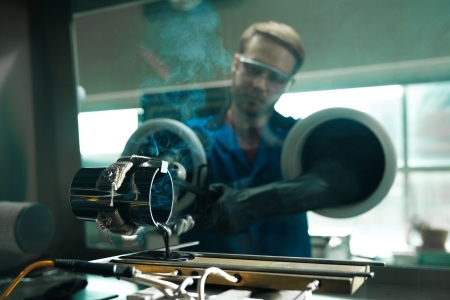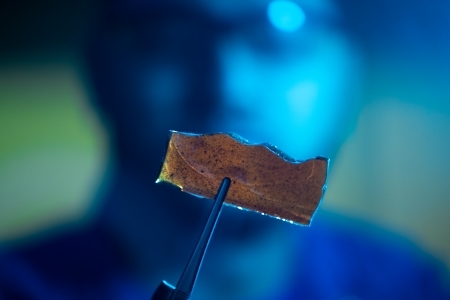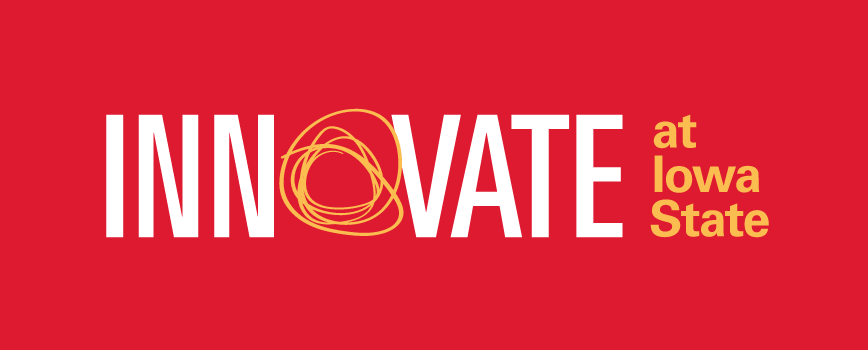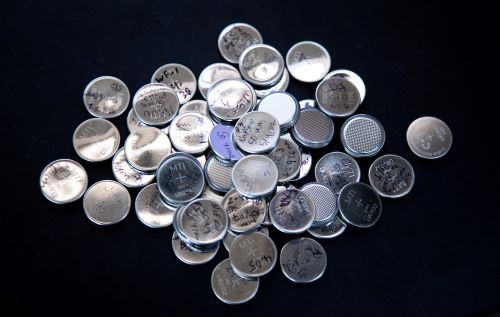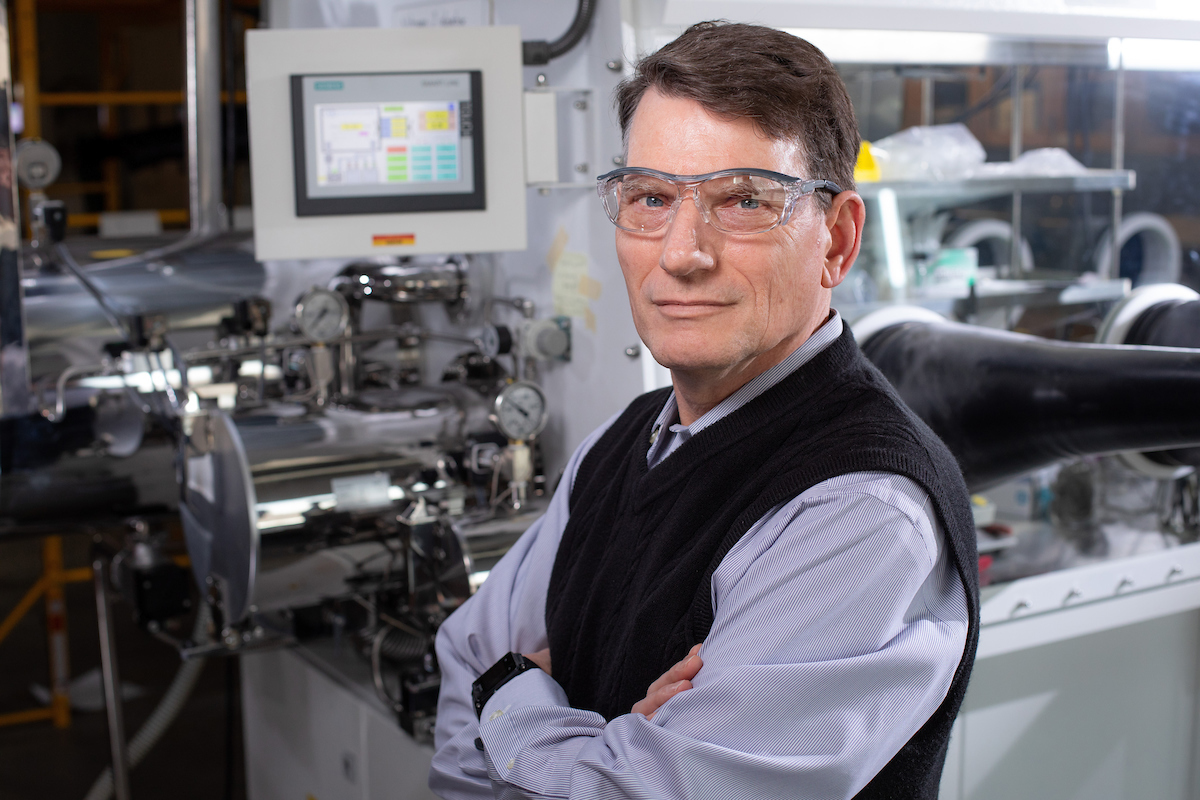
Steve Martin and the students in his lab are mixing new chemistries into glass to find just the right properties that improve battery performance. Larger photo. Photo by Christopher Gannon/Iowa State University.
By Mike Krapfl, News Service
AMES, Iowa – Steve Martin has seven plaques hanging above his office windows, each commemorating an invention or co-invention, each showing off the front page of an official U.S. patent.
As you’d expect, a patent is a technical document. Just browse those plaques in Martin’s Hoover Hall office, most of them related to new glassy materials:
“Oxy-thio-nitride mixed network former solid electrolytes”
“Mixed anion materials and compounds for novel proton conducting membranes”
“Infrared transmitting glasses with high glass transition temperatures.”
Then, digging around the patent records a little, one of Martin’s applications for another patent pops up:
“Removal of bubbles from molten glass”
Hey, we don’t have to be materials engineers to figure that one out. But getting rid of those bubbles is no easy thing. It involves molten glass surfaces exposed to low, sub-atmospheric pressures then high, super-atmospheric pressures, the steps “repeated as needed to produce a high quality, optically clear glass that is substantially free of bubbles.”
Martin – a University Professor since 2006, an Anson Marston Distinguished Professor in Engineering since 2009 and a faculty member in materials science and engineering since 1986 – specializes in something else we don’t have to be engineers to understand.
He and his research students are working to invent better materials for batteries so that we all have more powerful, longer-lasting, safer and quicker-to-recharge batteries for our phones, vehicles and other applications.
How much power and convenience?
Just look at this description of one of Martin’s projects:
Martin and researchers at the U.S. Department of Energy’s Oak Ridge National Laboratory in Tennessee will study “using glassy solid electrolytes to increase the energy density of lithium-ion batteries, which ultimately could allow electric vehicles to receive a full charge in only five minutes.”
Finally, some interest in battery research
Up in Martin’s suite of labs on the third floor of Hoover Hall on a recent afternoon, doctoral students Victor Torres III and Jacob Wheaton worked away in glove boxes designed to keep their battery materials and samples clean and pure. (See videos at right.)
Torres, both hands extended into a box’s rubber gloves, carefully poured molten glass into a mold to make a 1-centimeter test disc so the group could determine the ability of that glass to conduct ions, or charged particles. Wheaton ran another disc over sandpaper, polishing it by hand as part of the lab’s sample-preparation process.
Martin watched the action and talked about how his research career has changed over the years.
When he moved straight from his doctoral studies in physical chemistry at Purdue University in Indiana to a junior faculty position at Iowa State in April 1986, Martin’s first entry in his lab notebook was about building on his thesis studies of charged particles moving quickly through glass. That’s an important idea if you want to build better batteries.
Batteries work by moving electrons from an anode, through an external circuit such as a phone or electric motor, and back to a cathode. An electrolyte sits between the anode and cathode and allows ions to move back and forth, freeing up electrons for power discharge and then recharge.
Martin was working to improve the materials used for electrolytes, moving from a flammable liquid to a glassy, inflammable solid that still allows ions to move back and forth just as easily and fast.
He said he was one of four researchers in the world working on that kind of battery problem in the 1980s. That’s a good indication of how much funding was available for battery studies.
Then lithium-ion batteries hit the market in the early 1990s and rechargeable batteries became part of daily life. Most of the batteries we use are from China, South Korea and Japan, where governments have supported battery research and the growth of battery industries.
Now – Martin would say finally – there is support for U.S. battery research.
Researchers are writing proposals this spring, for example, to try to win grants from a new, four-year, $125 million Department of Energy program to support basic research leading to next-generation batteries and energy storage.
“The Energy Innovation Hub projects supported by this funding opportunity,” said the department’s announcement, “will accelerate discovery and scientific exploration of new battery chemistries, materials, and architectures for transformational energy storage technologies to be deployed in transportation and on the nation’s electricity grid.”
Properties, properties, properties
All that activity in Martin’s lab the other day?
“It’s years and years of learning, patience and practice to do this all right,” Martin said.
And that was just to make test samples – small discs of glass with different chemistries mixed in – so the group could run them through an impedance spectrometer to measure their properties, especially the ability of charged particles to move through them.
“There are 50 different properties to maximize,” Martin said. “If we can achieve that really fine-tuned composition, we will maximize the performance of batteries.”
A new project is going to take the idea of fine-tuning to an even finer level. Last fall, Martin and his research group began a two-year, $300,000 grant from a National Science Foundation program for “untested, but potentially transformative” research ideas. The projects are considered “high risk, high payoff,” according to the agency.
In this case, the late Evan Reed of Stanford University in California, who was a leader in the emerging field of computational materials science, used machine learning tools to come up with all kinds of ideas for better materials, including a better material mix for a solid battery electrolyte.
The computers say Reed’s compound would create batteries that hold 10 times more energy than traditional lithium batteries, as well as being safer, more durable and more resistant to energy decay.
Martin said Reed’s computations also predicted a three-hour charge time would drop to 20 minutes.
Are the computers right?
Martin and his research group – with the help of Kirill Kovnir, an Iowa State professor of chemistry – are going to use their lab and experimental expertise to find out. They’ll synthesize the computer-recommended compound and do proof-of-concept work to evaluate its effectiveness.
Martin calls the project “a beautiful collaboration” with “potential to be revolutionary.”
If that and all the other ideas being tested in Martin’s lab go well – inexpensive sodium solid state batteries, anyone? – Martin might be hanging more of those patent plaques above his office windows.
His work is about more than the patents, though.
Here’s Torres, the doctoral student who demonstrated how test discs are made, explaining the potential of the lab’s work and his interest in it: “Energy storage is of necessary importance to the world’s future. I wanted to be a part of that movement and work on a technological development that would not only have an impact on science, but also every person’s life.”
